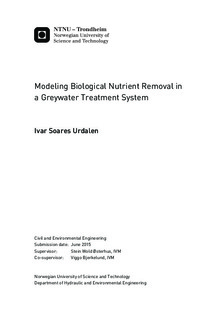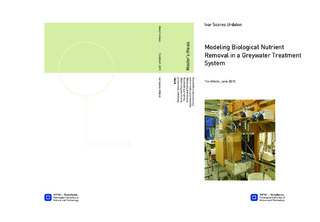| dc.description.abstract | Many urban centers suffer water scarcity due to increased population growth and dry periods. There has been an increased interest in developing alternative water sources for supplementing the existing urban water supply and for reducing urban water demand. One possibility for reducing urban water demand is by source separation of domestic wastewater into greywater and blackwater. The greywater fraction has been found to be responsible for up to 70% of the domestic wastewater volume. Therefore, greywater treatment represent a big potential of reducing the urban water demand if it can be reused for toilet flushing, garden/agricultural irrigation or for recreational use.
Greywater characteristics have been found to vary a great deal from different locations. Certain locations contain greywater with relatively high total phosphorus (Tot-P) concentration (e.g 7.5 mg P/L). Often total nitrogen (Tot-N) have been found to be quite low in greywater. If the greywater is to be reused for purposes that require low Tot-P and low Tot-N concentrations, it is essential to develop a sustainable greywater treatment system that is able to achieve this.
Tot-P and Tot-N can be removed biologically and biological nutrient removal (BNR) is an well-established technology that been widely applied for municipal wastewater treatment, but has yet to be implemented in full-scale for greywater treatment.
For high density urban areas there is a need for treatment systems with a low footprint and high capacity. Membrane Bioreactor (MBR) systems have lately emerged as a popular technology for greywater treatment, as it is a robust system with a low footprint that produces a high quality effluent that can be reused.
Therefore, a novel greywater treatment system based on Integrated Fixed-Film Activated Sludge (IFAS), BNR and MBR, is investigated with the activated sludge model ASM2d. The model was implemented in WEST (a wastewater treatment simulator software). The system was a pilot operated at the Norwegian University of Science and Technology (NTNU), and employed a modified UCT-MBR configuration for BNR.
A literature review of greywater treatment, BNR, IFAS, MBR, ASM models and how to conduct a modelling study is presented. The model is developed based on operational measurements of the pilot plant, and further calibrated by adjusting the influent characterization and the kinetic parameters. The model was used for sensitivity analysis of the operational parameters, and for proposing an optimized configuration of aeration settings, internal recycle streams, volumes and wastage rates. The uncalibrated model was able to successfully predict the effluent quality variables COD, Tot-P and Tot-N. However, the anoxic P uptake and soluble COD concentration in the anaerobic tank were not predicted successfully. | |

